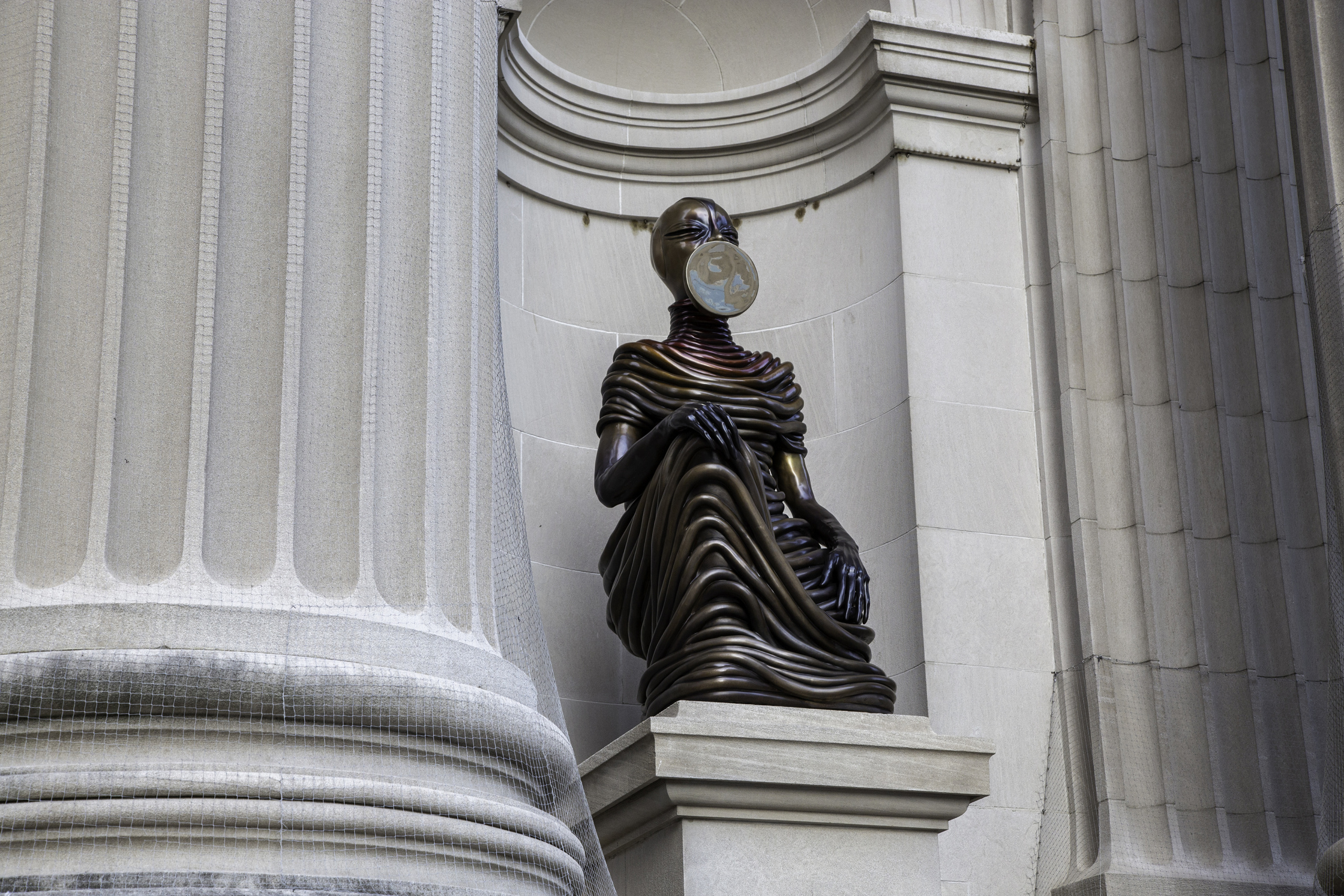
“It is easier to build monuments than to build a better world.” Black poet and teacher Carl Wendell Hines, Jr. wrote these words in 1965 upon the assassination of Malcolm X, warning of the limits of memorialization in his poem “A Dead Man’s Dream.” A recent wave of removals of monuments to imperialist and white supremacist figures across the country and the globe, and the simultaneous unveiling of memorials honoring women, offer an opportunity to engage with Hines’s assertion. Can monuments play a role in building better worlds? What kind of worldmaking is accomplished through the destruction or erection of statues? As works of public art that shape public imagination and serve as sites of memory and gathering spaces for collective action, what potential do new types of monuments have to help usher in other kinds of worlds? In particular, both artists and publics are reimagining the role that figures of Black women, long omitted from or denigrated in the United States commemorative landscape, can play in shifting our shared terrain.
She Built NYC, a public arts initiative led by New York City First Lady Chirlane McCray, exemplifies these efforts, with a plan to erect six new monuments across all five boroughs depicting trailblazing cis and trans women, four of them featuring Black women. These will include a Prospect Park monument of Representative Shirley Chisholm designed by Amanda Williams and Olalekan Jeyifous and a statue of Billie Holiday at Queens Borough Hall. An installation honoring activists Marsha P. Johnson and Sylvia Rivera in Greenwich Village will be, according to the city, the “first permanent, public artwork recognizing transgender women in the world.” Another initiative, Monumental Women, unveiled a Central Park sculpture in August 2020 honoring suffragists Sojourner Truth, Elizabeth Cady Stanton and Susan B. Anthony.
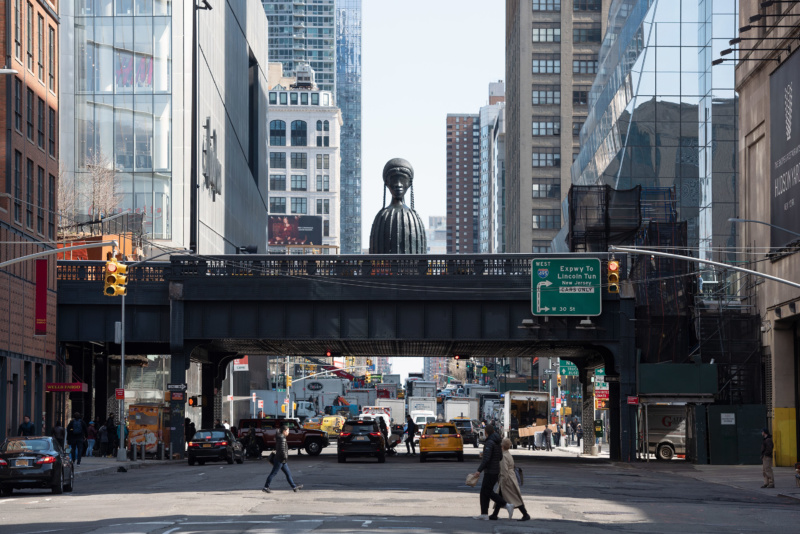
Several recent works of public art explore the relationship between genres of monumental sculpture, Black female subjectivity, and power. Simone Leigh’s Brick House (2019), a colossal bronze bust of a Black woman that merges the shapes of a skirt and a clay house, referencing architectural styles from West Africa and the US South, is currently on display on the High Line. Wangechi Mutu’s The NewOnes, will free Us, commissioned in 2019 by the Metropolitan Museum of Art, featured four futuristic bronze female figures seated in the niches built into the museum’s face. The figures are rendered in the form of caryatids, common to both Greek architecture and sculpture from across the African continent, but made freestanding to liberate them from their traditional role of holding up structures. “I didn’t want [them] to carry the weight of something or someone else,” Mutu explained. As Black women are often called on to be, in the words of Zora Neale Hurston, “mules of the world,” bearing the weight of oppressive systems, it is important to consider the possibilities and limits of numerous initiatives to depict their bodies and lives in monuments, especially amidst the national and global reckoning with the landscape of public art.
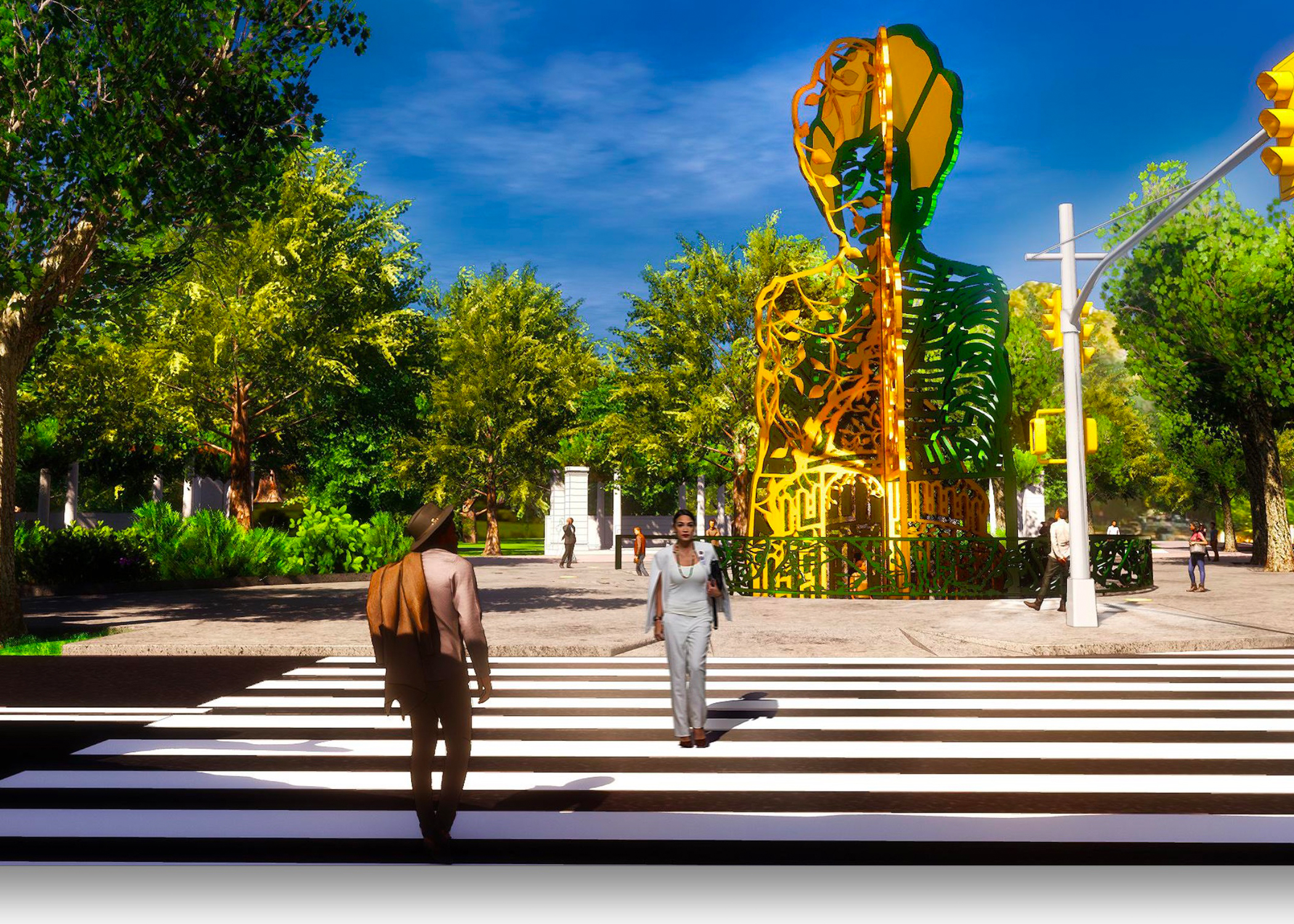
2020 was a monumental year for monuments. Around the globe, longstanding movements to rid public space of figures who championed colonialism, slavery, apartheid, indigenous genocide, racism, and anti-blackness in societies still shaped by these ills gained momentum in the wake of widely circulating imagery of police violence, particularly set off by the worldwide witnessing of the public execution of George Floyd. Demonstrators in Bristol, England threw a statue of slave trader Edward Colston into the harbor. A statue of British colonialist John Hamilton was taken down in Hamilton, New Zealand when Māori elders threatened to remove it by force. After it was set on fire and defaced, city officials in Antwerp removed the figure of King Leopold II, who perpetrated gruesome abuses as colonial ruler of the Belgian Congo. When a bust of Cecil Rhodes, mining magnate, British imperial administrator and ideologue who envisioned white rule from the Cape to Cairo, was beheaded in Cape Town, South African President Cyril Ramaphosa announced a campaign to remove racist statues, stating that “any symbol, monument or activity that glorifies racism, that represents our ugly, has no place in democratic South Africa.” In the United States, uprisings reignited generations of struggle against Lost Cause monuments to Confederates and other historical figures who espoused white supremacy. In Richmond, after protesters toppled a Jefferson Davis statue (1907) on Monument Avenue, a street lined with memorials to Confederate figures, the city took down three additional statues and initiated a process of removing a controversial memorial to Robert E. Lee from 1890. In Philadelphia officials removed a statue of former mayor and police commissioner Frank Rizzo, notorious for policies and rhetoric that exacerbated police brutality against Black people. In June 2020, New York City’s American Museum of Natural History requested that the city remove a statue of Theodore Roosevelt, depicted on horseback above an African man on his left and a Native American man on his right. Activists have been demanding this for decades, citing Roosevelt’s hostility to Native Americans and the imperialism that marked his presidency. Ellen V. Futter, president of the museum, told the New York Times, “We have watched as the attention of the world and the country has increasingly turned to statues as powerful and hurtful symbols of systemic racism.”

It is not a coincidence that as these bronze, marble and stone men are being uprooted, ground is breaking on public arts campaigns to honor women. The strikingly racist commemorative landscape of the United States is also profoundly misogynist and cis/heteronormative, reflecting the interlocking nature of various systems of domination that work together to maintain the status quo, what bell hooks calls “imperialist white supremacist capitalist patriarchy.” According to the Smithsonian American Art Museum’s Art Inventories Catalog, of the nearly 5,200 public outdoor statues in the US, only 394, just over seven percent, represent women. Up until 2020, five of New York City’s 150 statues of historic figures depicted women. Only one of them, Alison Saar’s Harlem monument to Harriet Tubman, portrayed a Black woman. That changed in August when Central Park welcomed its first sculpture of nonfictional women in its 167-year history.
The Women’s Rights Pioneers Monument, sculptor Meredith Bergmann’s portrayal of suffragists Truth, Anthony and Stanton, was unveiled on August 18, 2020 to coincide with the 100th anniversary of the 19th Amendment’s ratification. Though hailed as part of a new tide of public art, the statue has not been immune from the kinds of critiques targeted at the idols of bigoted white men. The original design only included Anthony and Stanton, omitting the efforts of Black suffragists while illuminating the racism that riddled the mainstream suffrage movement, whose leaders were often indifferent or hostile to Black, indigenous, immigrant and working women. As detailed vividly in Angela Davis’s Women, Race & Class (1981), though white suffragists often came to the women’s movement through abolitionism, many, including Anthony and Stanton, opposed the 15th amendment, which extended voting rights to Black men, because it excluded women. They declined to take public stances on anti-Black violence when urged to by contemporaries like Ida B. Wells, and appeased Southern legislators by assuring them the 19th amendment would not threaten Black disenfranchisement. “Black women,” Davis argues, “were virtually invisible within the protracted campaign for woman suffrage.” Bergmann’s sculpture was on track to enshrine this invisibility, if not for the sustained opposition that led to multiple redesigns.
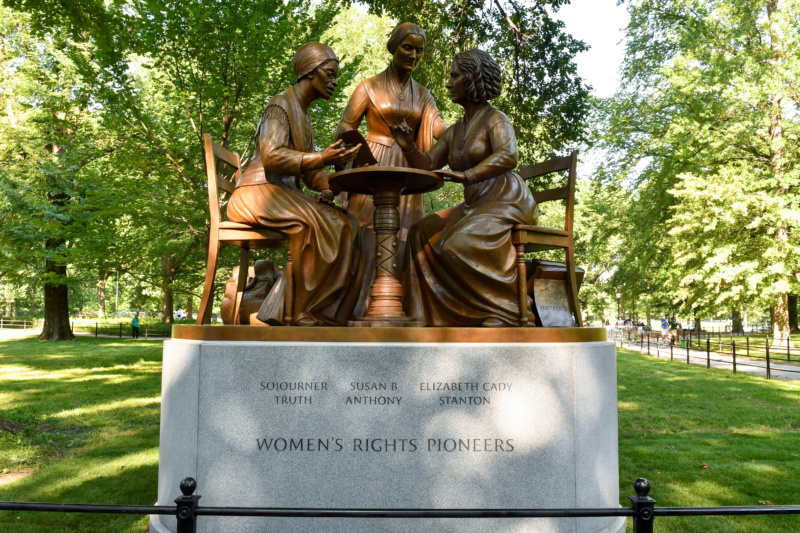
Though the original design depicted Anthony and Stanton holding a scroll featuring names of 22 other suffragists, including Truth, Wells, Mary Church Terrell and Anna Julia Cooper, only after public pushback did Bergmann add the figure of Truth, an abolitionist and suffragist who demanded freedom from both racist and sexist domination, most famously in her 1851 “Ain’t I a Woman?” speech. First she was shown listening to Anthony and Stanton, then, after additional critique, depicted speaking. The final design remains contentious, as illustrated in a letter from 20 leading historians arguing it “could obscure the substantial differences between white and black suffrage activists, and would be misleading.”
While a less conventional monument might have avoided the twin problems of exclusion and historical distortion, according to the Times, the Parks Department “would not allow an overtly modern or conceptual artwork.” Bergmann and Paula Elam, president of Monumental Women, have described the statue as “breaking the bronze ceiling,” firmly positioning the memorial within a lean-in feminism concerned with a narrow conception of inclusion in the catalog of mostly male statues, rather than a more expansive vision of public art’s potential to express a radical imagination. Elam told reporter Ginia Bellafante, “The bottom line is we are committed to inclusion, but you can’t ask one statue to meet all the desires of the people who have waited so long for recognition.”
Black women, surely included among these “people who have waited so long for recognition,” have had to contend not only with erasure from the US commemorative landscape, but also with the perils of inclusion. This is perhaps most strikingly captured in the 1923 Senate authorization of a monument to be built in Washington, D.C. “in memory of the faithful slave mammies of the South,” sponsored by the United Daughters of the Confederacy. One proposed model depicted an enslaved woman cradling a white child while her own children clung to her dress seeking attention, and another pictured a seated mammy figure nursing a white infant. The bill failed in the House in response to pressure from Black political organizing. Two thousand Black women submitted a petition opposing the monument. In a searing editorial indicting the project in The Evening Star, Mary Church Terrell, founding president of the National Association of Colored Women, stated, “One cannot help but marvel at the desire to perpetuate in bronze or marble a figure which represents so much that really is and should be abhorrent to the womanhood of the whole civilized world (The Black Mammy Monument, 1923).”
Though the attempt to erect a mammy monument in the nation’s capital failed, this harmful depiction of Black women remains enshrined in several public monuments. In Fort Mill, South Carolina’s Confederate Park, a memorial to “faithful slaves” features an enslaved woman coddling a white baby. In the Confederate Monument at Arlington National Cemetery, a weeping, loyal mammy holds a baby up to his white father, a Confederate officer, for a goodbye kiss. Campaigns like She Built NYC and Monumental Women that aim to increase the representation of women in the public arts landscape must grapple not only with the ways that women have been omitted but also with the harmful ways Black women have been imagined in memorials that enlist their bodies to perpetuate white supremacist narratives.
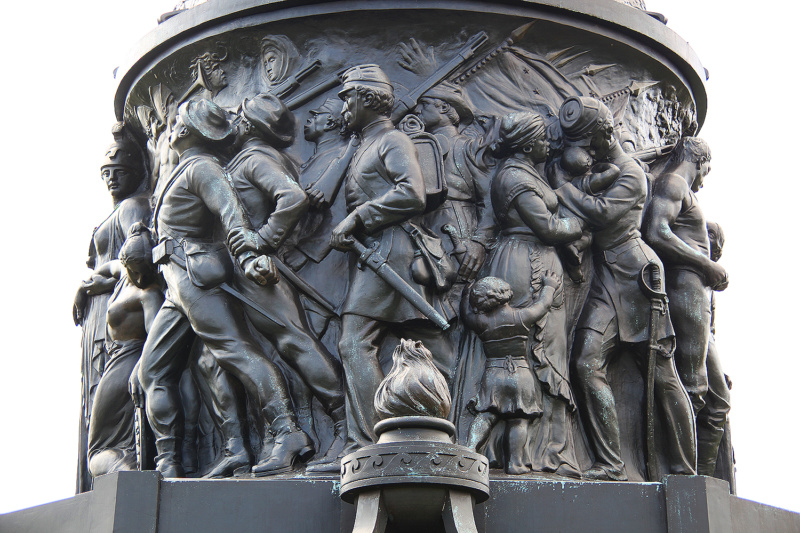
While lots of attention has been given to debates over what should happen to harmful monuments, we must also ask what interventions we expect new types of monumental structures to make in the landscape of public art and, more importantly, public consciousness. She Built NYC, slated to unveil its first monument in 2021, stands out for the prominent place it intends to offer cis and trans women of color, particularly Black women. However, if the arrival of works celebrating Black women amidst the overdue toppling of racist monuments is exploited to serve a simple redemption narrative of diversity and representation—“breaking the bronze ceiling”—this could further entrench the silences and distortions already etched into the memorial terrain. To avoid conscripting the memories of deceased Black women into inclusion narratives that belie the contested politics of their lives, the monuments on the way, whether they depict prominent figures or the nameless people in the collective movements they represented, must be able to generate dialogue out of metal and stone. As Mutu says of her attempt to turn the monumental form on its head and contend with its weighty history, “form and material actually impacts us. How they look is very much about what they mean.”
She Built NYC has the potential to transform the city’s public arts landscape, but Hines’s poetic warning that “it is easier to build monuments than to build a better world” lingers. He tells us, “Dead [wo]men make such convenient heroes/ for they cannot rise to challenge the images/ that we might fashion from their lives.” What does it mean to erect monuments depicting the leaders of struggles still very much ongoing? For example, the erection of a monument honoring Shirley Chisholm’s efforts to ensure access to participation in the political process is underway on the heels of a general election plagued with rampant voter suppression. As plans begin for a memorial including Marsha P. Johnson, whose activism addressed transgender people’s greater exposure to incarceration, homelessness and violence, these issues remain, while questions around her own death linger.
Amanda Williams and Olalekan Jeyifous, the artists chosen to design the first She Built NYC work, the Chisholm Memorial, at the Ocean Avenue and Parkside Avenues entrance of Brooklyn’s Prospect Park, seem to understand the political stakes of this project. They are invested in reimagining what a public memorial can be and do and how it might help activate people to work toward worlds otherwise. Chisholm was the first Black woman elected to Congress, where she represented New York’s 12th Congressional District from 1969 to 1983 and championed education and childcare, food and nutrition programs for the poor, fair wages, healthcare and other social services. She was also the first Black woman to run for the presidential nomination of a major party. Williams says their design, “Our Destiny, Our Democracy,” approaches the monument as “an invitation to participate”: it merges the congresswoman’s iconic portrait with the silhouette of the US Capitol, creating a towering form that will rise over an amphitheater-style gathering space, with seats bearing inscriptions honoring women who came after her. Both artists have made previous work for and about public spaces and will also work together to create public art for the entrance of the National Public Housing Museum in Chicago. The artists suggest that their backgrounds in architecture make them less beholden to conventional conceptions of what monuments should be: “We are… trained in how to use space as a medium… That proclivity toward space as an occupiable object inherently begs to be participatory and invites engagement. That seemed like a perfect analogy to Chisholm’s philosophy on democracy.”

Beyond high-profile public arts initiatives backed by massive private funds, we might also look to grassroots movements for examples of the dynamic role public art can play in building new worlds. For example, guerilla memorials created by activists in Mexico City highlight contemporary social problems, like violence against women, abductions by police and government corruption and negligence. These metal and concrete structures, called antimonumentos, are clandestinely drilled into the ground in strategic locations during protest actions to call attention to social issues and to occupy public space more permanently than with marches, according to art historian Alberto Híjar. For example, in front of the Mexican Stock Exchange, a bright red number 65 commemorates the dozens of coal miners killed in a 2006 explosion in Coahuila. It placed pressure on the government that helped lead to the announcement of a forthcoming operation to recover their bodies. Across from the Palace of Fine Arts in early 2019, a purple structure was erected featuring a raised fist circled by pink crosses with a message that reads, “NO + FEMINICIDIOS,” or no more femicides, calling for state action to protect women from violence. As government officials have not acted to remove them, these anti-monuments have become part of the urban landscape, mingling with and offering a counternarrative to Mexico City’s myriad historic monuments. Echoing this movement, Williams and Jeyifous have said that they aim for their Brooklyn public installation dedicated to Shirley Chisholm and “the people yet to be born… of her legacy” to be an “anti-monument” that challenges the conventional nature of monuments as “static and in a fixed moment in time.”
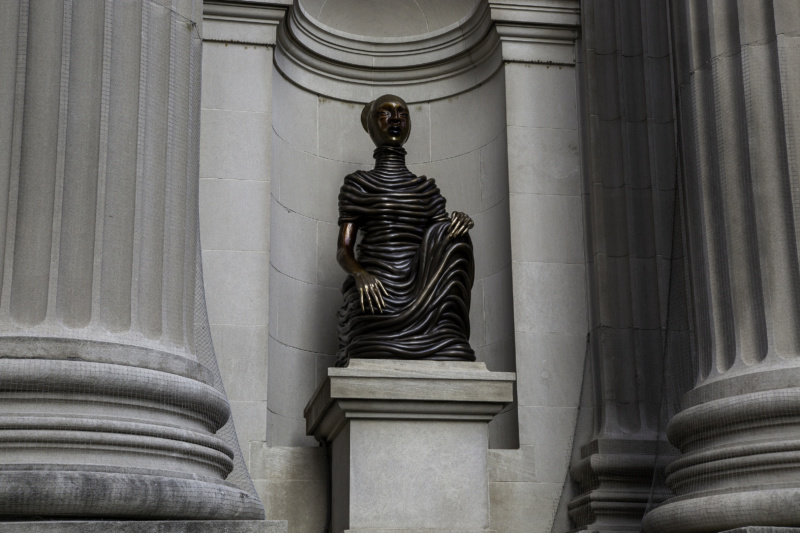
Public art can serve as a powerful medium for occupying space, telling counter-histories and imagining and enacting alternative futures. Initiatives to include portrayals of Black women in American public art represent significant opportunities, but artists must understand the complex history of Black women’s inclusion and omission in the US commemorative landscape if they are to avoid erasure and distortion or co-opting women’s images into sanitized narratives. If approached carefully, the process of building more expansive and dynamic monuments can play a role in the building of better worlds. In order to build, we must collectively imagine, and public art is an integral part of this process. As Wangechi Mutu shows, artists must pair a deep sense of history with an ability to break free from the weight of conventional forms if they are to build monuments that can help call forth worlds otherwise. Describing her nameless monumental women who defiantly graced the façade of the Met, simultaneously appearing to be from the past and the future and challenging the very history of that institution, she said, “I want these figures to appear to have come from elsewhere, from afar… They look as if they are charged with a role and responsibility. They have come to look and bear witness, and to reflect back to us what we are. Amid the deep existential crisis we are immersed in, The Seated (2019)—conveying a presence that is as much celestial as it is deeply human—aim to send a signal that things can and shall be different.”

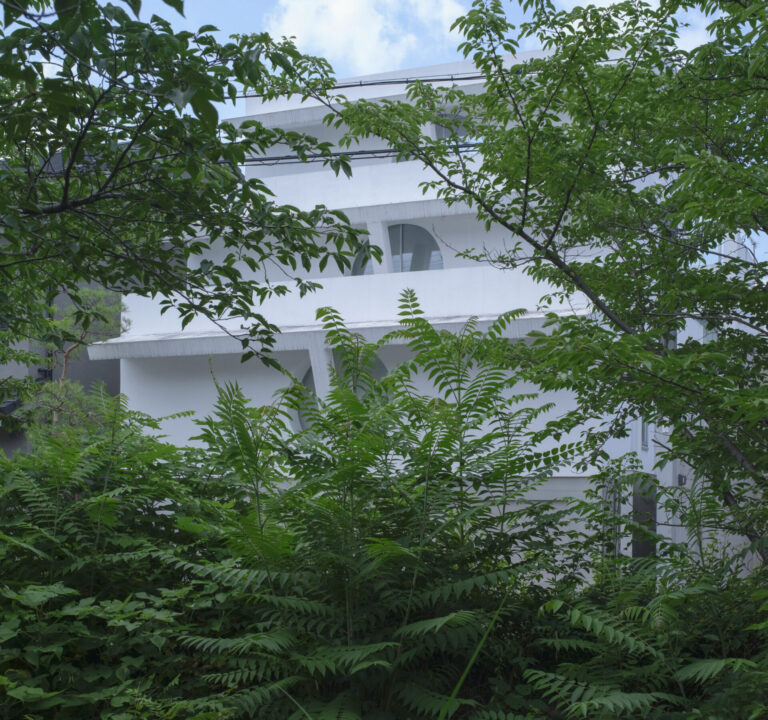
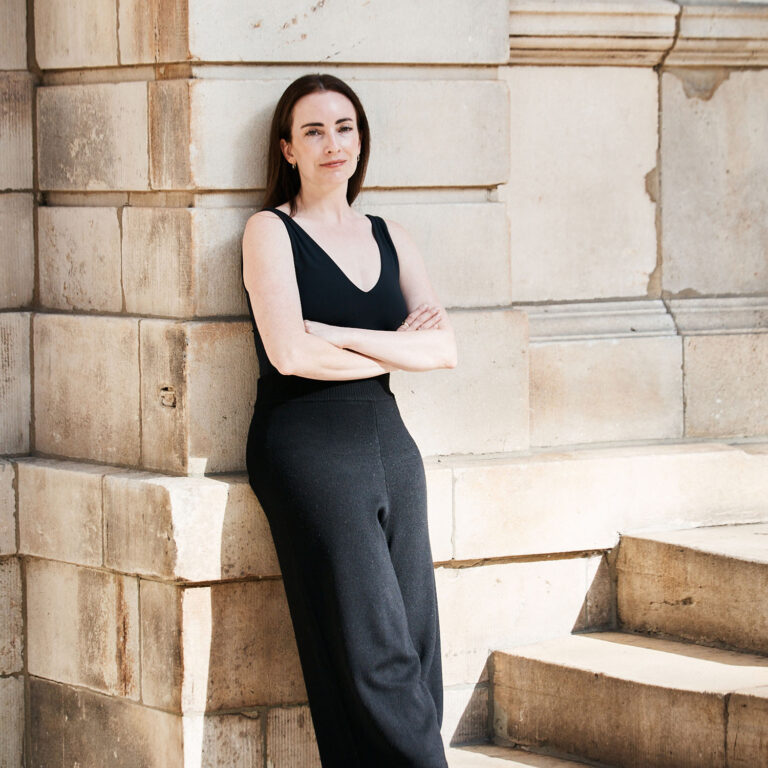







 in your life?
in your life?

